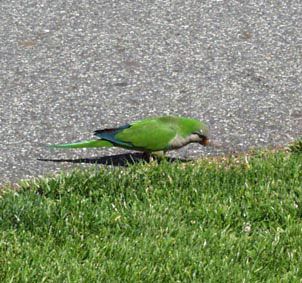
MONK PARAKEETS
at Brooklyn College:
Invaders from the South?
Eleanor Miele
This is the challenge that first year students in the Masters Program in Elementary Science & Environmental Education were given in September of 1999 and 2000:
What's going on with the Monk Parakeets? Surely you have seen those green escapees flying over left field? And right field. And all over campus. Monk parakeets are a feral bird population--once domesticated animals living in the wild. They are a non-native introduced species. Are these birds getting too successful for the health of Brooklyn's native wild bird population? The pigeon is one example of a non-native introduced species that has become established in North America. The
house sparrow is also not from around these parts originally. The most recently introduced "foreign" bird is the starling. These have become among the most common birds in Brooklyn. Beginning with some research on the internet, let's look into the question -- are the Monk Parakeets at Brooklyn College the vanguard of an invasion?Monk Parakeet Links:
Start with some basic information about monk parakeets from The Birds of North America, No. 322, 1998 (Excerpts) Mark F. Spreyer and Enrique H. Bucher.
Our starting question is, "Are monk parakeets invading Brooklyn?" Read: Are Monk Parakeets Pests? Ornithologists Aren't Sure by Glenn Zorpette in Scientific American for some insight. Then check out The Monk Parakeet: Guilty Until Proven Innocent: An essay on the status of monk parakeets as pests.
Commercial Sources for Monk Parakeets are still around, this page provides some links to information on captive birds.
Monk Parakeets have discovered more than one campus. There is a colony of Monk Parakeets at the University of Bridgeport in Connecticut. Other parakeets in that state were observed by Connecticut Audubon Society members Linda Pearson and Alison Olivieri who conducted a multi-year study of the birds.
Monk Parakeets are also found at the University of Chicago. While a student there, Jason South created the Hyde Park Parakeets web page.
Monk Parakeets have also settled around the University of Texas campus in Austin, Texas. Erik Heubner has published research on these parakeets Online.
Providers of electrical service have discovered that feral Monk Parakeets like to build nests on transformers.
Florida Monk Parakeet Survey: is an example of another research project. Also check out The Monk Parakeet Page, with comments on legal issues and links to information on invasive species and essays about monk parakeets.
Having explored some of these sources, let's search for additional information. Use a search engine to do your own search for information about Monk Parakeets (also known as Quaker Parakeets) on the 'Net. Just click on the words "search engines" to begin your search. Remember that to return to this page you can hit the back button on your browser. Jot down the URL or http://... address of any good sites you find to share and for future reference.
As we design a baseline study of this colony over the course of the semester we will publish the
results of our research
online. Our research project will help us learn to teach to the National Science Education
Standards of the National Research Council of the National Academy of
Sciences. The project also meets the recommendations of the North American
Association for Environmental Education outlined in Guidelines
for the Initial Preparation of Environmental Educators and will prepare
educators to teach to the learning standards in environmental education outlined
in Excellence in
Environmental Education Guidelines for Learning (K-12).
Access the Results of the Monk Parakeet Study
Find out more about the Brooklyn College M.S. in Elementary Science and Environmental Education.
To Brooklyn College School of Education Homepage
To Science Education Homepage
Comments to Emiele@brooklyn.cuny.edu
Last Updated 3/20/01